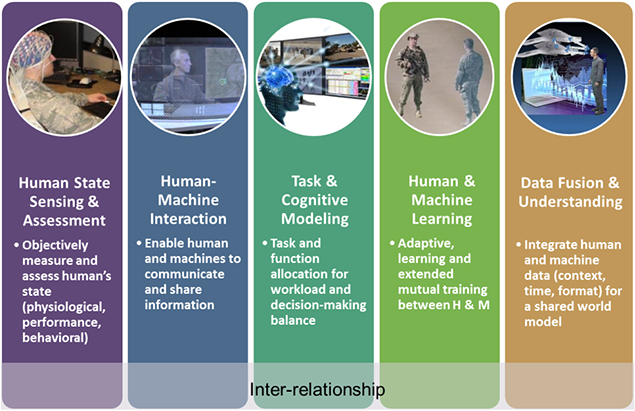Human Machine Teaming
AFRL aims to improve human-machine teaming and machine intelligence. In fact, AFRL predicts the “heaviest dollars” in research, across the services, are going to those two areas, he said. In addition, the lab is trying to create deliberate planning for extensive research on teams of heterogeneous unmanned platforms that can work together. In this Human Machine Teaming subdomain piece of autonomic research, it is imperative to focus design decisions on the explicit allocation of cognitive functions and responsibilities between the human and computer to achieve specific capabilities.

Multimedia
The PowerPoint, podcast and video on this page address the creation of actively coordinated teams of multiple machines that can self-organize into teams and are capable of initiating and completing complex mission tasks.
- AFRL Autonomy Part 2: Demonstrated Highly Effective Human-Machine Teaming Goal (Watch Video on YouTube)
- Video Transcript available for download (PDF)
- Autonomy Strategy Slide Deck – Part 2 (PDF)
Human-robot interaction (HRI) is a relatively new, multi-disciplinary field that addresses how people work or play with robots versus computers or tools. This is a subset of the larger field of human-system interaction (HSI), as the focus is on bi-directional, cognitive interactions in which the robot is a physically situated agent operating at a distance from the user, versus a computer on autopilot, thus leading to significant distinctions. HRI addresses six basic research issues: how humans and machines communicate; how to model the relationship between humans and machines for accomplishing autonomy vital to combat missions; how to study and enhance human-machine teamwork; how to predict usability and reliability in the human-machine team; how to capture and express the human-machine interactions for a particular application domain; and how to characterize the warfighters and combat capabilities.
The benefits to DoD on focusing on the human-machine system versus the platform are: improved performance, reduced cost of operating and designing platforms, increased adaptability of existing systems to new situations and accelerated adoption. Better human-machine teamwork leads to faster performance of tasks with fewer errors. Better teamwork, improved communication interfaces and improved usability and reliability for applications reduce the number of humans needed to operate the system. They also reduce the cost of designing efforts.